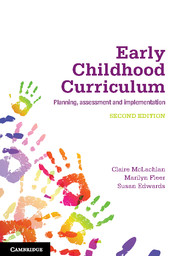Book contents
- Frontmatter
- Contents
- About the authors
- Acknowledgements
- 1 Introduction
- 2 Theory, research and the early childhood curriculum
- 3 Development and learning – how views of development shape how curriculum is framed
- 4 Curriculum as a cultural broker
- 5 Interpreting early childhood curriculum
- 6 Cultural-historical curriculum in action
- 7 Curriculum as a conceptual tool: Observation, content and programming
- 8 Assessing children and evaluating curriculum
- 9 Content knowledge: The sciences, maths and numeracy
- 10 Content knowledge: Language, literacy and ICT
- 11 Content knowledge: The arts and health, wellbeing and physical activity
- 12 Conclusions
- Glossary
- References
- Index
4 - Curriculum as a cultural broker
- Frontmatter
- Contents
- About the authors
- Acknowledgements
- 1 Introduction
- 2 Theory, research and the early childhood curriculum
- 3 Development and learning – how views of development shape how curriculum is framed
- 4 Curriculum as a cultural broker
- 5 Interpreting early childhood curriculum
- 6 Cultural-historical curriculum in action
- 7 Curriculum as a conceptual tool: Observation, content and programming
- 8 Assessing children and evaluating curriculum
- 9 Content knowledge: The sciences, maths and numeracy
- 10 Content knowledge: Language, literacy and ICT
- 11 Content knowledge: The arts and health, wellbeing and physical activity
- 12 Conclusions
- Glossary
- References
- Index
Summary
Learning intentions
This chapter is intended to help you learn:
that the curriculum can ‘broker’ children’s learning by building on and exploring their knowledge and the experiences they bring to early childhood settings from their family and community
that children’s social situations are comprised of the relationships they have with significant adults in their lives, and that changing social situations represent new learning opportunities for young children
that curriculum is a dynamic concept and that the curriculum needs of young children change over time in response to social, cultural and economic changes in local communities.
This chapter highlights how early childhood practices are enacted in different cultural communities and related to curriculum decision-making processes. These examinations will be used to show how different curricula are informed by alternative perspectives on development and learning, and by their political contexts. A case study of teacher practice will be used to show how this process is related to a cultural-historical perspective. Research emerging from the use of cultural-historical theory as an informant of the early childhood curriculum will then be used to discuss curriculum as a cultural construction affecting a range of stakeholders, including teachers, families, children, communities and policy makers.
- Type
- Chapter
- Information
- Early Childhood CurriculumPlanning, Assessment, and Implementation, pp. 46 - 56Publisher: Cambridge University PressPrint publication year: 2013



